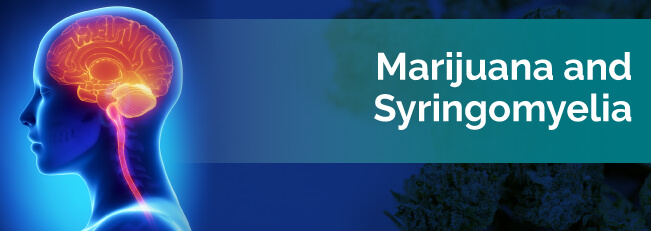
Syringomyelia affects the spinal cord and often happens after trauma to the spine. Pain is a prominent symptom of the condition. While some patients are eligible for surgery to relieve the symptoms of syringomyelia, others simply rely on pain relievers, which can cause serious side effects. Understanding how medical marijuana can relieve syringomyelia symptoms helps you determine if it’s an appropriate treatment for you.
Syringomyelia is a condition that causes a cyst, also called a syrinx, in the spinal cord. Spinal fluid fills the cyst, often causing it to grow and press on the spinal cord. While syringomyelia is a benign condition, it can cause spinal cord damage due to the pressure it creates. Per 100,000 people, estimates suggest syringomyelia occurs at a rate of 8.4 cases.
The cause of syringomyelia can vary from one patient to the next. One common cause is a trauma to the spinal cord due to things like car accidents or serious falls. Syringomyelia may not show up right away after the trauma — in some cases, it doesn’t appear until years after the initial incident.
Other causes of acquired syringomyelia include meningitis, hemorrhage, tumors and arachnoiditis. The incident sparking acquired syringomyelia causes spinal cord damage, which is where the syrinx forms. Pain often travels upward starting at the point of injury.

Medical conditions can also cause syringomyelia. In those cases, an obstruction disrupts the normal flow of cerebrospinal fluid, which pushes it into the spinal cord and forms a syrinx. The fluid continues to fill the cyst, which grows and potentially causes damage.
Arnold-Chiari malformation is one such congenital medical condition that can lead to syringomyelia. With this condition, the cerebellum has structural defects, which increases the chances of developing syringomyelia.
Symptoms of syringomyelia often depend on the condition’s severity. As the cyst grows, it causes pressure on the spinal cord and may cause damage. As that pressure and damage increases, the symptoms tend to worsen.
The symptoms directly related to syringomyelia can often develop slowly over time. Affected individuals may experience an inability to distinguish hot objects from cold or perhaps find they have a loss of pain and temperature sensation on the back and arms. The direct pressure from the built up fluid on the spinal cord can also cause weakness, stiffness, numbness, pain and scoliosis.
Symptoms may only affect one side in some people as well. In addition to the common signs and symptoms, the condition may cause problems with sexual function and sweating, as well as bowel and bladder control.
The specific location of the syrinx can also affect what symptoms you feel. For example, a location high on the spinal cord or on the brain stem can cause vocal cord paralysis, trigeminal nerve sensory loss and other symptoms.
Since the symptoms of syringomyelia don’t always show up immediately, it can be difficult to diagnose. For example, symptoms might begin to appear in early adulthood, but a diagnosis may not occur until mid-life.
Diagnosing syringomyelia typically involves a few different tests. A neurological exam is often the first test performed to identify symptoms, such as sensation loss or movement difficulties. An MRI performed on the spine can confirm if the symptoms are caused by syringomyelia. The imaging test also reveals the location and severity of the issue to help doctors determine a course of treatment. The patient may also have an MRI of the head done to look for hydrocephalus or other conditions that could be the cause of the syringomyelia.
Depending on the cause and severity, there are several treatment options for patients suffering from syringomyelia. If the condition is caused directly by Hydrocephalus or Chiari Malformation, the syrinx can potentially resolve on its own. However, many cases need some type of treatment to improve the condition or at least to relieve the symptoms.
Surgery is the most common treatment method, with the goal of preventing further spinal cord damage and saving or improving functioning. The surgery also helps relieve spinal cord pressure and can help reduce pain and other symptoms caused by that pressure. Surgically, the syrinx can be drained if it expands greatly over time, and stents can be placed in the syrinx for long-term drainage. Potential side effects may include spinal cord injury, infection, blockages and hemorrhaging.

In other cases, patients undergo surgery to correct the root cause of the condition. For example, when the condition is caused by Arnold-Chiari malformation, surgery is used to give the cerebellum more space at the base of the skull. If a tumor causes syringomyelia, the surgery involves tumor removal. Another possible surgery used for the condition is to relieve decompression.
Not all patients with syringomyelia need surgery for the condition. If the condition is minor, the medical team may decide to hold off on surgery and continue monitoring the syrinx to ensure it doesn’t get worse. Operating on the spinal cord comes with potentially dangerous risks, so your health care team must evaluate the potential benefits and the risks to make sure surgery is worth it. If you wait too long to have surgery, though, the pressure can cause irreversible damage to the spinal cord.
Some patients with syringomyelia have temporary relief after surgery only to have the symptoms return. In these cases, the patient may have additional surgeries to keep the condition under control.
Patients with syringomyelia also use analgesics to control the pain associated with the condition. The type of pain reliever used depends on the location, type and severity of pain. Many patients take a combination of the pain relievers to address the different types of pain.
Some of the common types used include:
Any analgesics used for syringomyelia are used strictly to ease pain symptoms. They provide no curative value. In other words, they won’t improve the condition. They simply provide some relief. A major drawback of using these pain relievers is the potential for long-term damage to the liver. Regular blood tests help monitor the situation to identify any liver issues early.
Another potential problem with some pain relievers is the potential for addiction and abuse. This can cause additional problems that are difficult to beat.
Pain frequently accompanies syringomyelia. While surgery can ease the symptoms, many patients may still experience pain. Others aren’t eligible for surgery and must simply manage the pain. Cannabis for syringomyelia primarily serves as a safe, natural analgesic. Marijuana is known for its pain-relieving qualities. Ingesting medical cannabis often provides immediate pain relief, which can make the condition easier to handle.
While traditional pain relief may require different types of analgesics at the same time to treat the different types of syringomyelia pain, marijuana is known to treat a variety of different types of pain, including chronic pain, headaches, neuropathic pain and inflammation. Instead of taking several pills that can cause liver damage to address the different types of pain, you can use marijuana without any dangerous side effects. Some patients choose marijuana to manage the pain to avoid the risks of surgery. However, it’s important to work with your health care professionals when deciding whether or not to have surgery.

Chemicals in marijuana called cannabinoids work with your body’s endocannabinoid system. The endocannabinoid system helps regulate processes throughout the body to keep a sense of balance. The cannabinoids in marijuana work with the receptors throughout the body, which means marijuana can have a positive impact in various systems and areas.
Another beneficial relationship between marijuana and syringomyelia relates to muscle stiffness and spasticity. Patients with syringomyelia may experience these sensations, which can be uncomfortable and limiting. Marijuana can help to relieve both of them.
If the pain from syringomyelia keeps you awake at night, marijuana can help. Indica-dominant strains in particular can help to relieve your pain and also help you to feel sleepy. Between decreased pain and sleepiness, many patients find that marijuana helps significantly with sleep problems.
Specific research relating to cannabis and syringomyelia is limited due to federal regulations and marijuana’s status as a Schedule I drug. Despite the lack of official studies, many patients with syringomyelia and other health conditions that cause pain report significant relief with the use of marijuana.
Because syringomyelia is a progressive condition, medical marijuana can be utilized for immediate pain relief throughout the condition’s development. Some patients use marijuana to relieve pain when surgery is not an option. Others may continue experiencing some pain even after surgery, so they opt for marijuana to help control the pain further.
Cannabis is generally either sativa-dominant or indica-dominant strain. Some hybrids combine the two types. Both sativa and indica offer pain relief for the user. The primary difference is how each type makes you feel. Indica strains have a relaxing, sleepiness effect. Sativa strains have the opposite effect in most people, making them feel more energetic. To relieve associated headaches, migraines and generalized weakness caused by the syringomyelia, sativa strains are highly recommended.
Some strains of cannabis that may work well for syringomyelia include:
You may find certain strains work better than others. Just like patients react to prescription pain relievers differently, patients may also find relief from different strains of marijuana. Don’t assume that marijuana isn’t useful for you if you don’t feel the kind of relief you expect the first time. You may need to try different strains. Your experienced marijuana doctor can help you find a strain that works for you based on your personal medical history.
With your strain selected, you need to decide how to ingest it. Understanding different methods of ingestion helps you choose one that fits your needs. Common options include:
When you ingest cannabis, you’ll notice the effects take longer to kick in — anywhere from 30 minutes to several hours — but they also last longer. This makes edibles popular for bedtime use, as the pain relief can extend longer into the night.
Work with your medical marijuana doctor to determine which method of ingestion is right for you. The answer may be a combination of methods and marijuana strains. You might use a sativa strain ingested via smoking or vaporizing during the day. At bedtime, you might ingest an indica-dominant strain in an edible, so the effects last longer into the night.

Prescription pain medication comes with potential side effects, including long-term liver damage. Marijuana offers a relatively inexpensive and safe way to relieve pain associated with syringomyelia. While you will feel the effects of the marijuana, those effects aren’t dangerous or long-lasting. The effects end once the marijuana wears off, with no damage to the body. The effects are often mild as well.
You can expect the following effects of taking marijuana for syringomyelia:
If syringomyelia causes pain that interferes with your daily life, marijuana may be an affordable, safe alternative for getting relief without the dangerous side effects of prescription painkillers. If you would like more information about using marijuana to treat syringomyelia, we can help connect you to qualified marijuana doctors in all legal marijuana states. Book your appointment now to find freedom from syringomyelia pain.
For more information about how cannabis can be used to treat Syringomyelia, check out our resources:
Find A Doctor Find A Dispensary